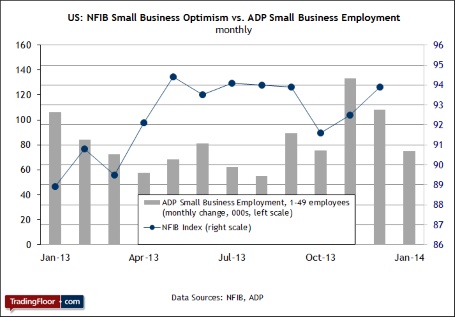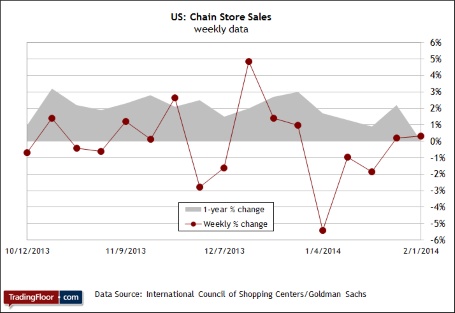Tuesday is a light day for Eurozone updates but several new numbers for the US will collectively provide a richer profile of how the economy is holding up, or not. First up is the monthly release of the National Federation of Independent Business (NFIB) Small Business Optimism Index, followed by the weekly estimate of chain store sales and the government’s Job Openings and Labor Turnover Survey (JOLTS). Bear in mind that Janet Yellen, the new US Federal Reserve chairman delivers her inaugural testimony to Congress today at 15.00 GMT — her first formal chit-chat in public with the government on monetary policy. It should be interesting to see how the markets react. On that note, we may see a transcript of her introductory remarks released in advance, perhaps as early as 13.30 GMT via the testimony corner of the Fed’s website.
US NFIB Small Business Optimism Index (12.30 GMT) Friday’s jobs report again raised the spectre of deceleration in the labour market, which of course would create headwinds for the economy. The jury’s still out on deciding if this is a risk worth worrying about, partly because there’s a reasonable if not fully convincing case that an unusually harsh winter may be temporarily suppressing payrolls. One way to decide whether the weather is, or isn’t, is to look at various survey measures, which in theory shouldn’t be victimised by meteorological factors. With that in mind, today’s report from the NFIB will be helpful for interpreting the slower rate of jobs creation of late.
In the last two updates, the NFIB index posted back-to-back gains, delivering the strongest run since the spring. “Two monthly advances could be the start of a more positive trend,” said NFIB’s chief economist Bill Dunkelberg in January. A month later, however, the small-business employment trend via Automatic Data Processing's (ADP’s) numbers suggests caution. Companies with 50 or fewer employees added a modest 75,000 workers in January vs. the previous month, according to last week’s release of the ADP Employment Report.
The sharp deceleration in growth in recent months suggests that the NFIB index will reverse course in today’s estimate for January. In fact, economists predict that this benchmark of sentiment in the small company sector will slip to 93.4 for last month — a marginal decline vs. December’s reading. If the forecast holds, we’ll have additional support for thinking that the labour market is suffering from a temporary case of winter doldrums rather than from a deeper problem.

US Chain Store Sales (12.45 GMT) This weekly report can be viewed as a canary in a coal mine. If there’s trouble brewing in the US economy, we are likely to see the macro cracks relatively earlier via slower consumer spending. That’s the key issue to focus on with today’s update of the International Council of Shopping Centers (ICSC) and Goldman Sachs Weekly Chain Store Sales Index.
The week-to-week changes for this benchmark are usually too volatile for drawing big-picture conclusions but the year-over-year pace is closer to providing a real-time assessment of consumer sentiment based on hard data. Today’s report may turn out to be especially valuable for deciding if there are clouds on the horizon. In last week’s release, the trend turned soft: annual sales were flat for the week through February 1. That’s the weakest year-over-year comparison in recent history and it may be a warning sign of things to come. But there’s the weather factor to consider. As ICSC’s chief economist Michael P Niemira last week reminded: "On the heels of the third snowiest final week of the fiscal month and year in more than 23 years, sales posted a sequential weekly gain but were flat on a year-over-year basis." He added that the severe weather had "curbed consumers shopping".
If the weather is truly the cause of the latest soft patch, we might see the evidence with a stronger batch of numbers today. On the other hand, another weak report (even one that shows annual sales contracting a bit) may not yet be a smoking gun for expecting deeper woes ahead. But this much is clear: the bearish outlook will gather strength if today's data disappoints. In turn, a weak report may influence thinking about Thursday’s update of the broader gauge of spending as calculated in the government’s retail sales report.

US Job Openings and Labor Turnover Survey (15.00 GMT) We already know that the pace of jobs creation has been relatively sluggish lately and so in some respects today’s JOLTS report isn’t going to reveal anything that wasn’t already obvious. In fact, today’s release, as usual, lags behind the payrolls report by one month. Nonetheless, the JOLTS data may provide additional clues for deciding how, or if, the weather played havoc on the labour market recently.
Today’s release covers the jobs market for December, which was the first month of the current deceleration. Last week’s January payrolls report brought some modest improvement but not enough to dismiss the possibility that the rough patch could roll on. The main question is: how does the pace of job openings for December compare with the previous month? As you can see in the chart below, the number of openings has been increasing in recent months, albeit at a mild pace. Nonetheless, the trend has been encouraging.
Given the weak payrolls data for December, however, it wouldn’t be surprising to see today’s estimate of openings turn lower. A dramatic fall would be troubling as it would suggest that there was more than weather behind the feeble rise in payrolls at last year’s close. How should we define “dramatic fall”? My back-of-the-envelope guesstimate: a drop below 3.8 million (roughly the level from last July) would signal that the labour market is facing troubles that won’t be easily cured by an early spring. Alternatively, a dip that keeps openings above 3.8 million will keep the crowd guessing about the next big move in the labour market.

